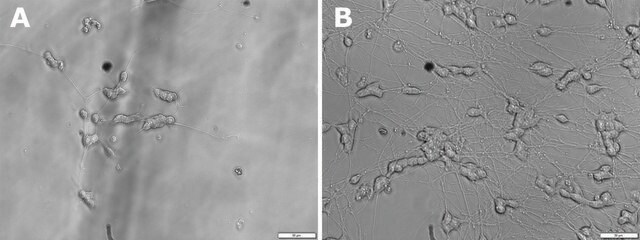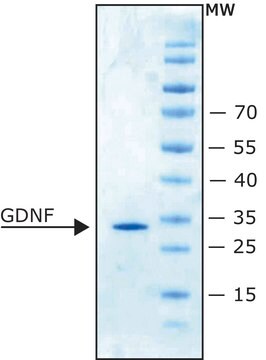추천 제품
제품명
Ciliary Neurotrophic Factor human, CNTF, recombinant, expressed in E. coli, lyophilized powder, suitable for cell culture
생물학적 소스
human
Quality Level
재조합
expressed in E. coli
분석
≥95% (SDS-PAGE)
양식
lyophilized powder
효능
≤325 ng/mL ED50 ((≥ 3.1 x 103 units/mg))
품질
endotoxin tested
분자량
22.8 kDa
포장
pkg of 10 and 20 μg
저장 조건
avoid repeated freeze/thaw cycles
기술
cell culture | mammalian: suitable
불순물
≤10 EU/μg
UniProt 수납 번호
저장 온도
−20°C
유전자 정보
human ... CNTF(1270) , CNTF (1270)
일반 설명
The CNTF (ciliary neurotrophic factor) gene encodes a cytokine, and is mapped to human chromosome 11q12.1.
애플리케이션
Ciliary Neurotrophic Factor human has been used to study its effect on photoreceptor neuroprotection and Muller glial cell proliferation in zebrafish retina. It has also been used to study the effects of intravitreal injection of ciliary neurotrophic factor (CNTF) on photoreceptor injury and BRB (blood-retinal barrier) breakdown in transgenic model.
생화학적/생리학적 작용
Ciliary neurotrophic factor (CNTF) was first identified as a survival factor for neurons from the ciliary ganglion of chicken embryos. Most of its known actions are restricted to cells of the nervous system, including motor neurons, sympathetic ganglion neurons, sensory neurons, hippocampal neurons, and medial septal neurons. CNTF also prevents degeneration of motor axons after axotomy and promotes astrocyte differentiation and oligodendrocyte survival and maturation. Outside the nervous system, CNTF maintains embryonic stem cells in an undifferentiated, pluripotent state. CNTF is structurally related to leukemia inhibitory factor (LIF), interleukin-6 (IL-6), interleukin-11 (IL-11) and oncostatin M (OSM). CNTF exerts its actions through the activation of the high-affinity CTNF receptor complex, which contains the ligand-binding α-subunit (CNTF Rα) and two signal transducing β-subunits (LIF Rβ and gp130). The LIF Rβ subunit is also shared by receptors for LIF and OSM. The gp130 subunit is also shared by receptors for LIF, OSM, IL-6, and IL-11. CNTF is localized in the cell nucleus subsequent to receptor binding. Human and rat CNTF share ~83% sequence homology and show cross-reactivity in bioactivity.
Ciliary neurotrophic factor was first identified as a survival factor for neurons from the ciliary ganglion of chicken embryos. Most of its known actions are restricted to cells of the nervous system, including motor neurons, sympathetic ganglion neurons, sensory neurons, hippocampal neurons and medial septal neurons. CNTF also prevents degeneration of motor axons after axotomy and promotes astrocyte differentiation and oligodendrocyte survival and maturation.
물리적 형태
Lyophilized from a sterile (0.2 micron) filtered aqueous solution containing 10 mM sodium phosphate, pH 7.5
분석 메모
The proliferative activity is tested in a cell proliferation assay using the cytokine-dependent human erythroleukemic cell line, TF-1.
Storage Class Code
13 - Non Combustible Solids
WGK
WGK 3
Flash Point (°F)
Not applicable
Flash Point (°C)
Not applicable
개인 보호 장비
Eyeshields, Gloves, type N95 (US)
이미 열람한 고객
Genomic variants, genes, and pathways of Alzheimer's disease: an overview
Naj AC, et al.
American Journal of Medical Genetics. Part B, Neuropsychiatric Genetics : the Official Publication of the International Society of Psychiatric Genetics, 174(1), 5-26 (2017)
CNTF induces photoreceptor neuroprotection and Muller glial cell proliferation through two different signaling pathways in the adult zebrafish retina
Kassen SC, et al.
Experimental Eye Research, 88(6), 1051-1064 (2009)
Weiyong Shen et al.
The Journal of neuroscience : the official journal of the Society for Neuroscience, 32(45), 15715-15727 (2012-11-09)
Müller cells are the major glia of the retina that serve numerous functions essential to retinal homeostasis, yet the contribution of Müller glial dysfunction to retinal diseases remains largely unknown. We have developed a transgenic model using a portion of
Rachelle W Johnson et al.
Bone, 64, 47-56 (2014-04-12)
Muscle and bone are intimately linked by bi-directional signals regulating both muscle and bone cell gene expression and proliferation. It is generally accepted that muscle cells secrete factors (myokines) that influence adjacent bone cells, but these myokines are yet to
Mansour Haidar et al.
Autophagy, 15(6), 1051-1068 (2019-01-24)
HSPB1 (heat shock protein family B [small] member 1) is a ubiquitously expressed molecular chaperone. Most mutations in HSPB1 cause axonal Charcot-Marie-Tooth neuropathy and/or distal hereditary motor neuropathy. In this study we show that mutations in HSPB1 lead to impairment
자사의 과학자팀은 생명 과학, 재료 과학, 화학 합성, 크로마토그래피, 분석 및 기타 많은 영역을 포함한 모든 과학 분야에 경험이 있습니다..
고객지원팀으로 연락바랍니다.











